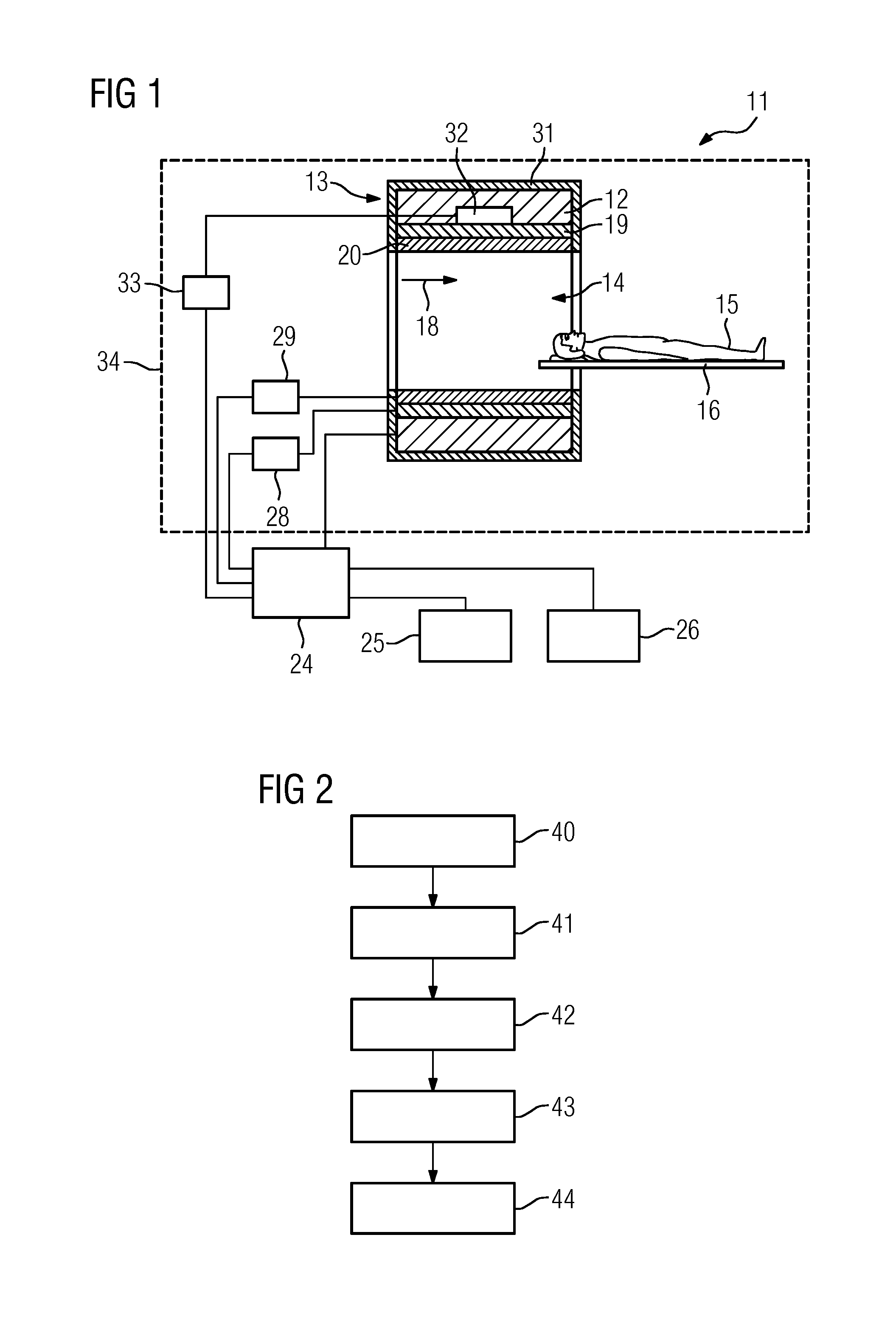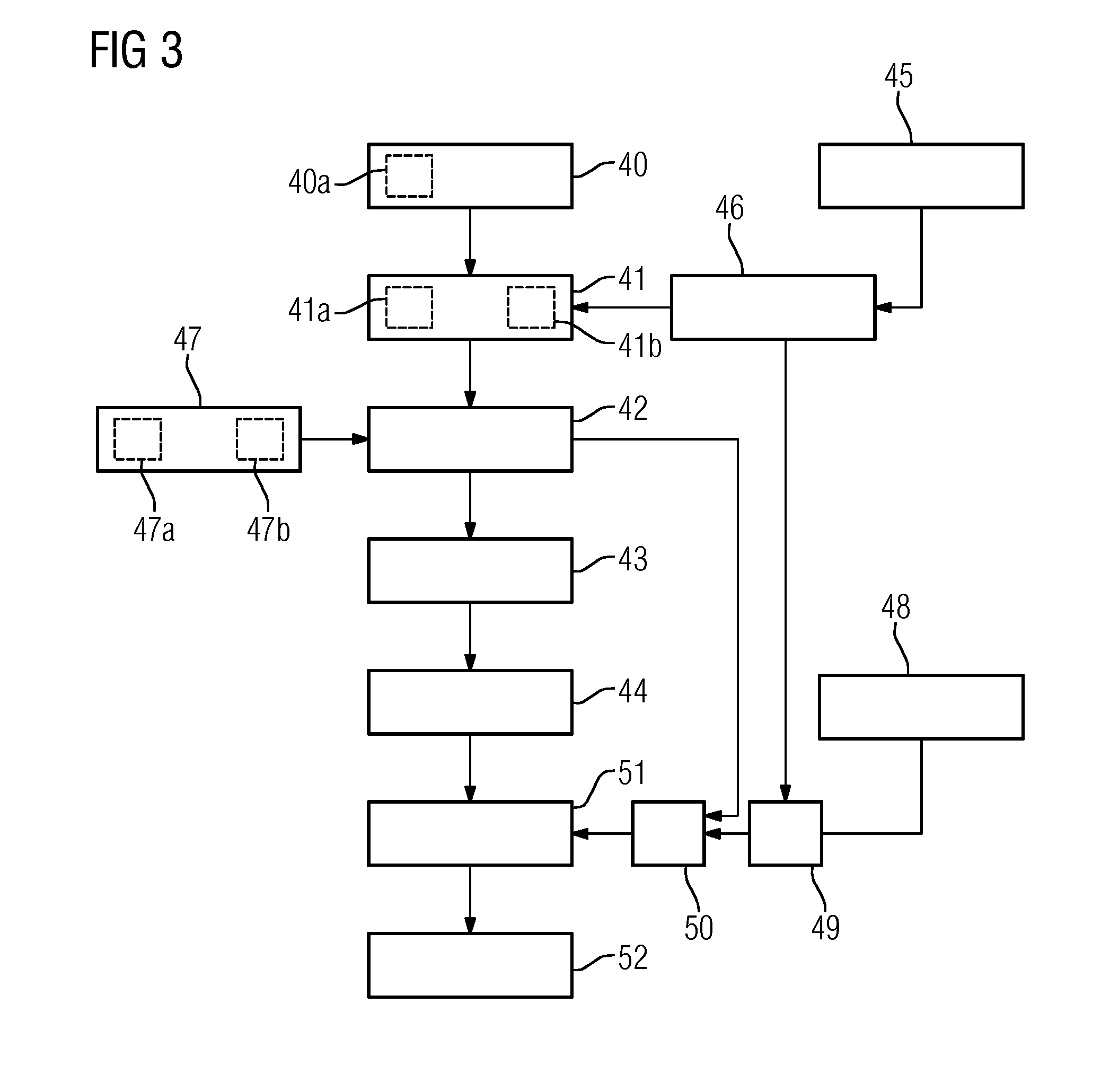Magnetic Resonance Imaging
a magnetic resonance imaging and magnetic resonance technology, applied in the field of magnetic resonance imaging and magnetic resonance devices, can solve the problems of restricting the existing homogeneity of the main magnetic field, further source of inhomogeneity, and recording of inferior magnetic resonance image data, so as to and improve the quality of the calculated b0 map
- Summary
- Abstract
- Description
- Claims
- Application Information
AI Technical Summary
Benefits of technology
Problems solved by technology
Method used
Image
Examples
first embodiment
[0043]FIG. 2 shows a flow diagram of a method for magnetic resonance imaging of an object under investigation 15 using a magnetic resonance device 11.
[0044]In a first method act 40, first magnetic resonance image data of the object under investigation 15 is acquired by an image data acquisition unit 34 of the magnetic resonance device 11. This may take place, for example, during recording of a three-dimensional scout view at the start of an investigation of the object under investigation 15. In act 41, the first magnetic resonance image data is segmented by a segmenting unit (not shown) of the computer unit 24 into at least two material classes. In act 42, a calculating unit (not shown) of the computer unit 24 calculates a B0 map based on the segmented first magnetic resonance image data and based on susceptibility values of the at least two material classes. In a further act 43, shim settings are calculated by the shim control unit 33 based on the calculated B0 map. In method act 4...
second embodiment
[0045]FIG. 3 shows a flow diagram of a method.
[0046]The following description is essentially restricted to the differences from the exemplary embodiment in FIG. 2, where, with regard to method acts that remain the same, reference is made to the description of the exemplary embodiment in FIG. 2. Method acts that are substantially the same are essentially identified with the same reference signs.
[0047]The second embodiment of the method shown in FIG. 3 essentially includes the method acts 40, 41, 42, 43, 44 of the first embodiment of the method, as shown in FIG. 2. The second embodiment of the method shown in FIG. 3 also includes further method acts and sub-acts. Also conceivable is an alternative method sequence to that of FIG. 3 that has only part of the additional method acts and / or sub-acts09 represented in FIG. 2. An alternative method sequence to that of FIG. 3 may also have additional method acts and / or sub-acts.
[0048]The acquisition of the first magnetic resonance image data i...
third embodiment
[0052]FIG. 4 shows a flow diagram of a method according to one or more of the present embodiments.
[0053]The following description is essentially restricted to the differences from the exemplary embodiment in FIG. 2, where, with regard to method acts that remain the same, reference is made to the description of the exemplary embodiment in FIG. 2. Method acts that are substantially the same are essentially identified with the same reference signs.
[0054]The third embodiment of the method shown in FIG. 4 essentially includes the method acts 40, 41, 42, 43, 44 of the first embodiment of the method, as shown in FIG. 2. The method sequence shown in FIG. 4 includes the further method act 47 of the second embodiment of the method in FIG. 3. In addition, the third embodiment of the method shown in FIG. 4 also includes further method acts and sub-acts. An alternative method sequence to that of FIG. 4, which has only part of the additional method acts and / or sub-acts represented in FIG. 2, may ...
PUM
 Login to View More
Login to View More Abstract
Description
Claims
Application Information
 Login to View More
Login to View More - R&D
- Intellectual Property
- Life Sciences
- Materials
- Tech Scout
- Unparalleled Data Quality
- Higher Quality Content
- 60% Fewer Hallucinations
Browse by: Latest US Patents, China's latest patents, Technical Efficacy Thesaurus, Application Domain, Technology Topic, Popular Technical Reports.
© 2025 PatSnap. All rights reserved.Legal|Privacy policy|Modern Slavery Act Transparency Statement|Sitemap|About US| Contact US: help@patsnap.com



